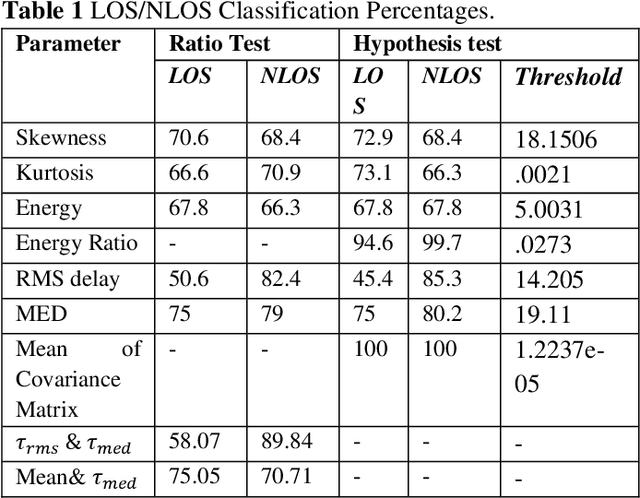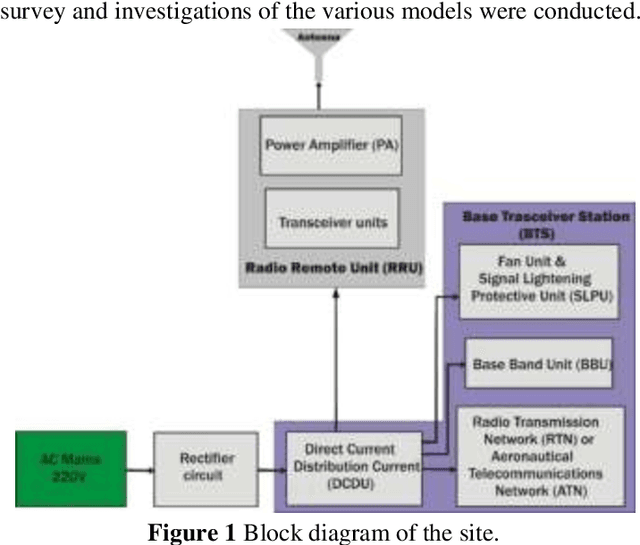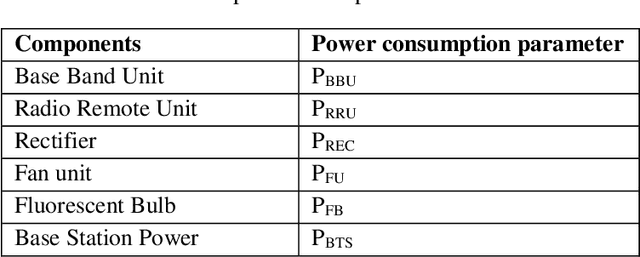Mohammed Dahiru Buhari
Statistical LOS/NLOS Classification for UWB Channels
Aug 15, 2023



Abstract:Ultrawideband (UWB) technology has attracted a lot of attention for indoor and outdoor positioning systems due to its high accuracy and robustness in non-line-of-sight (NLOS) environments. However, UWB signals are affected by multipath propagation which causes errors in localization. To overcome this problem, researchers have proposed various techniques for NLOS identification and mitigation. One of the approaches is statistical LOS/NLOS classification, which uses statistical parameters of the received signal to distinguish between LOS and NLOS channels. In this paper, we formulated several techniques which can be used for effectively classifying a Line of Sight (LOS) channel from a Non-Line of Sight (NLOS) channel. Various parameters obtained from Channel Impulse Response (CIR) like Skewness, Kurtosis, Root Mean Squared Delay Spread (RDS), Mean Excess Delay (MED), Energy, Energy Ratio, and Mean of Covariance Matrix are used for channel classification. In addition to this, the Joint Probability Density Functions (PDFs) of various parameters are used to improve the accuracy of UWB LOS/NLOS channel classification. Two different criteria-Likelihood Ratio and Hypothesis Tests are used for the identification of the channel.
On-site Energy Utilization Evaluation of Telecommunication Base Station: A Case Study of Western Uganda
Aug 15, 2023



Abstract:Due to the widespread installation of Base Stations, the power consumption of cellular communication is increasing rapidly (BSs). Power consumption rises as traffic does, however, this scenario varies from geolocation to geolocation because sites in rural and urban areas have variable traffic loads. Therefore, in order to address various power consumption issues, it is necessary to analyze these sites and offer valid data that network operators can employ. This study took into account the impact of traffic load on energy consumption both in rural and urban locations in western Uganda because prior models did not adequately account for the impact of traffic load on both rural and urban sites. Regression models are used to examine these effects of traffic load on power consumption. Based on measurements taken for twenty-eight days in a row in six urban and rural areas, linear models have been presented. The findings showed that both rural and urban BTS were well-fitted by the suggested linear models. Depending on the layouts of the sites, it was found that energy consumption varied along with traffic, with the number of transceivers present having an impact on both the traffic load and energy consumption.
FANET Experiment: Real-Time Surveillance Applications Connected to Image Processing System
Jun 15, 2023Abstract:The major goal of this paper is to use image enhancement techniques for enhancing and extracting data in FANET applications to improve the efficiency of surveillance. The proposed conceptual system design can improve the likelihood of FANET operations in oil pipeline surveillance, and sports and media coverage with the ultimate goal of providing efficient services to those who are interested. The system architecture model is based on current scientific principles and developing technologies. A FANET, which is capable of gathering image data from video-enabled drones, and an image processing system that permits data collection and analysis are the two primary components of the system. Based on the image processing technique, a proof of concept for efficient data extraction and enhancement in FANET situations and possible services is illustrated.
 Add to Chrome
Add to Chrome Add to Firefox
Add to Firefox Add to Edge
Add to Edge